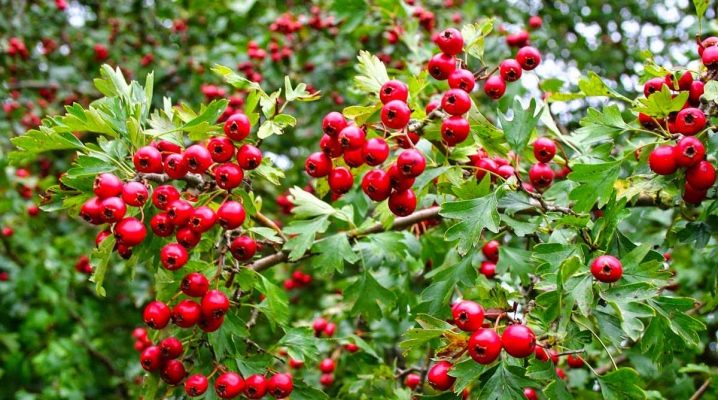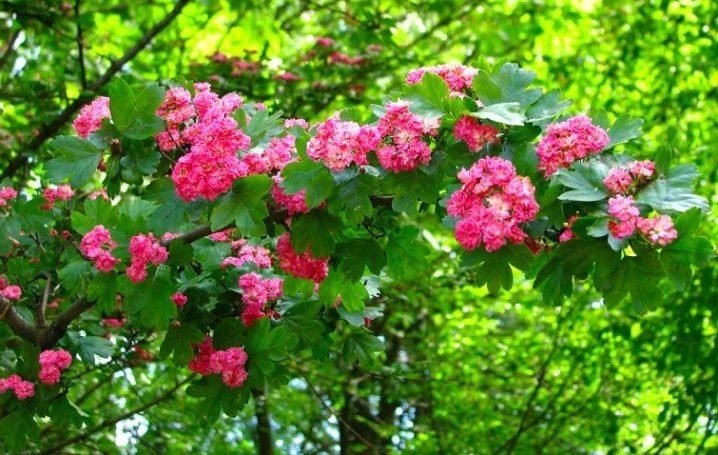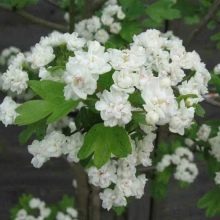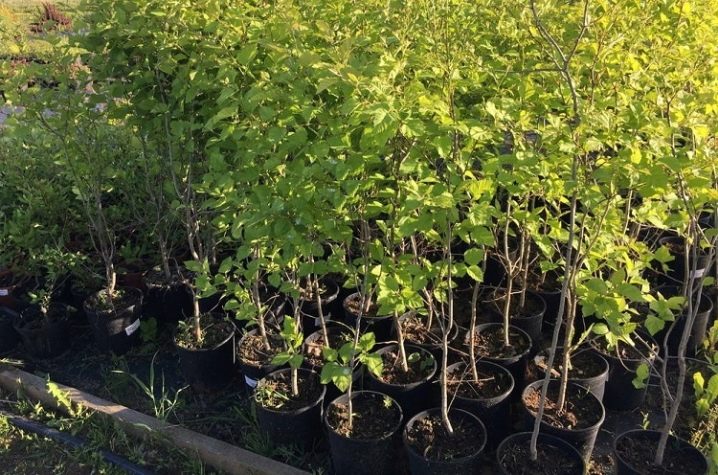Features of single-footed hawthorn and its cultivation

Abundant flowering and fruiting make the common hawthorn popular with many gardeners. The advantage of this variety is the ease of caring for the crop.

general description
The hawthorn is one-pistil, it is also one-seed, got its name due to the peculiarities of the structure: there is one pistil in the flower and, accordingly, one stone. This plant can take two forms: a shrub and a small tree. Its height is on average from 3 to 6 meters, but sometimes it reaches 8-12 meters. There are long-lived specimens 200-300 years old, rising at the level of 17-18 meters and having a spherical crown with a diameter of 18-20 meters. The shoots of the hawthorn are different: they are completely bare, with dense hairs at the beginning, or covered with one-centimeter thorns. On the branches are glossy leaves, dark on top and light on the bottom, as well as ovoid buds that grow in length up to 3-5 millimeters. The shape of the leaf differs depending on the location.
The inflorescences of the culture are represented by complex scutes, consisting of 10-18 flowers and reaching a diameter of 5 centimeters. The buds open from May to June. Pollination of hawthorn is carried out with the help of insects. The fruits of the plant are apples of brown-red or yellow shades. Their length does not exceed 7-10 millimeters, and inside there is a single large bone. Fruits with sweet pulp appear on the branches in September. The member of the genus Hawthorn and the Rose family has many uses. It can be bred exclusively for decorative purposes, used as a honey plant or for obtaining fruits, or used in medicine.
The presence of a powerful root system allows the plant to do without watering for a long time. Its characteristics include high frost resistance.


Popular varieties
The wild single-pistil hawthorn became the ancestor of many hybrid varieties now grown in gardens. Among themselves, they differ in the shape of the crown, the shade of the leaf blades and the appearance of flowers. For example, there are pyramidal and weeping varieties. The inflorescences of the plant are colored crimson, pink, snow-white or red.
Some shrubs are covered with variegated leaves, and white stripes are found on the petals of other flowers.
- The variety "Rosea Flore Plena" is very popular. with double inflorescences of dark pink color. On a tree with a spreading crown, rounded, bright red fruits appear. The flowering of the variety begins in June.
- Often used in landscaping and one-footed hawthorn "Strickta". This variety is characterized by the presence of a crown with branches looking up. The tree grows to a height of 6-8 meters. The shape of its leaves is reminiscent of maple leaves.
- At the hawthorn "Pendula" weeping branches grow, sometimes even with yellow bark.
- "Alba Plena" grows into a spherical shrub with a height of 2.5 to 3 meters. It is covered with long burgundy thorns and white double flowers. The color of the leathery leaf blades changes from dark green to yellow-orange.
- Hawthorn "Rubra Captivity" can take the form of both a shrub and a small tree. The dense crown is abundantly covered with ruby inflorescences and tough light green leaves.
- Variety "Compact" refers to dwarf globular shrubs that grow no more than 3 meters. Its bloom lasts from May to June and is accompanied by the appearance of snow-white flowers.



Landing
Planting of seedlings of hawthorn monopathic on the site is organized in autumn or spring. If the plant is at the age of 2 years, then it is better to transfer it to open ground in the spring, so that it can take root reliably before wintering. This should be done only when the soil temperature warms up to + 4-5 degrees. For specimens older than 5 years, autumn is more suitable: next spring, a young bush will bloom and even delight with a small number of fruits. It is important to keep within the first September decade, so that at least 1.5 months remain before frost. The exact dates are determined depending on the climatic characteristics of the region.
An open and well-ventilated area, but with diffused light, is recommended for single-footed hawthorn. Even partial shading can harm the culture: the plant will bear less fruit, and in general it will look worse. Any soil is suitable, but always drained. The plant is not able to develop in wetlands. The optimum acidity is 7.5-8 pH. Poor lands are necessarily enriched with humus and wood ash.
It is also recommended to make sure that there are no apples and pears with similar pests nearby.

Hawthorn seedlings are placed in single holes or in a single trench with an interval of 50 centimeters. The second option is recommended in cases where it is planned to grow a hedge. If the seedlings grow separately, then 2 to 3 meters will have to be left between the pits. The indentations should be 70 centimeters deep and the same width. A drainage layer forms at the bottom, and sand is poured on top - in general, about 20 centimeters.
It is recommended to dip the seedlings into a stimulating preparation, for example, "Kornevin", before planting, and also to treat the root system against fungal infections. If necessary, long roots are cut from the plant and broken shoots are eliminated. The planting itself begins with the fact that a mixture of a compost bucket and 100 grams of nitrophoska is distributed over the drainage. The root of the seedling is lowered into a clay mash and set vertically in the center of the pit. It is important that the root collar remains above the surface. The free space is filled with soil, and the planting is irrigated with warm liquid. A day later, the trunk circle will need to be mulched with sawdust, chips and pieces of tree bark.

Care
The unpretentious monopestile hawthorn requires only the most basic care.
Watering and feeding
The culture is able to survive the lack of water, but its excess can be disastrous, leading to the decay of the plant. Ideally, young seedlings are irrigated once every 2 weeks, and adult plants - once a month, on average, about 10 liters of liquid is poured under each bush. The presence of a mulch layer will allow you to retain moisture in the soil to the maximum.
Until the hawthorn blooms, it should be fed with urea, and in the fall, at the end of the season, the plant will need a mixture of potassium, phosphorus and nitrogen. If desired, at the time of bud formation, the culture is fertilized with Agricola.


Pruning
Trimming the crown of the hawthorn is carried out depending on the design idea. For example, when forming a hedge, bushes are processed horizontally and vertically. No less often, the plant is given a standard form. A similar design of the shrub is carried out in the autumn, and in the spring, frozen and dried twigs are removed from the specimens.
If the hawthorn is located in a well-lit area, then its crown will be correct in itself, and all that remains is to carry out preventive pruning. Rejuvenation is required for those bushes that have reached the age of 6-7 years.As part of this procedure, only 2-3 old branches are eliminated. If necessary, rid the plant of faded inflorescences and internal branches of too thickened specimens.

Wintering
Before winter, shrubs up to 6 years old are subject to mandatory mulching. Plants are huddled, after which they are protected with a layer of sawdust, dry foliage and needles. If the summer was dry, then the plant will need to organize water-charging irrigation.
An adult one-footed hawthorn does not require special preparation for a cold snap. If a cold snap is expected to -35-40 degrees, then you can throw snow at the trunk to the maximum height or wrap it in burlap.

Reproduction
The hawthorn can be independently propagated by cuttings, layering, offspring and seeds.
- For grafting, it is required to take young twigs, in which about half of the stem is already stiff. The workpieces are cut at an angle of 45 degrees using a sharp, alcohol-disinfected tool. The branches are submerged in moist soil and watered until shoots appear on them. Further, the hawthorn can be transferred to its permanent habitat, where it will grow and take root.
- Reproduction by layering is the easiest way: the branch is tilted to the soil, fixed with a special bracket and sprinkled with earth. When the shoot takes root, it only remains to be separated from the mother plant and transplanted to another place.
- Suitable for breeding purposes and suckers growing on the root.
- Finally, it is suggested to use seeds. The material, which has undergone 12-month stratification, is distributed along grooves, the depth of which does not exceed 1.5 cm. Crops are covered with dry foliage, coniferous branches or a protective cloth.
The emergence of seedlings will have to wait for a long time, up to a year.


Diseases and pests
Common hawthorn usually does not feel well in cases when it grows in the shade, stays for a long time in conditions of high humidity or at low temperatures. It is likely that the culture is infected with powdery mildew, from which the crown suffers most.
In this case, the affected parts will have to be cut off immediately, and the plant itself should be sprayed with copper sulphate or Pure Flowers. In order not to attract pests, shrubs are prophylactically treated with copper-containing preparations. Insecticide "Iskra" helps the plant against apple aphids, and "Dursban" - for leafworms.


Use in landscape design
Hawthorn can be grown singly or be part of group compositions. An unpretentious plant responds well to a haircut, and therefore it manages to give it any shape. Often, culture is used to decorate hedges, park edges or recreational areas. With the help of shrubs, you can also place the necessary accents on the lawn.
An organically flowering plant looks like a background of dwarf conifers.





































































The comment was sent successfully.